stop start YAMAHA FX HO CRUISER 2019 User Guide
[x] Cancel search | Manufacturer: YAMAHA, Model Year: 2019, Model line: FX HO CRUISER, Model: YAMAHA FX HO CRUISER 2019Pages: 116, PDF Size: 12.33 MB
Page 52 of 116
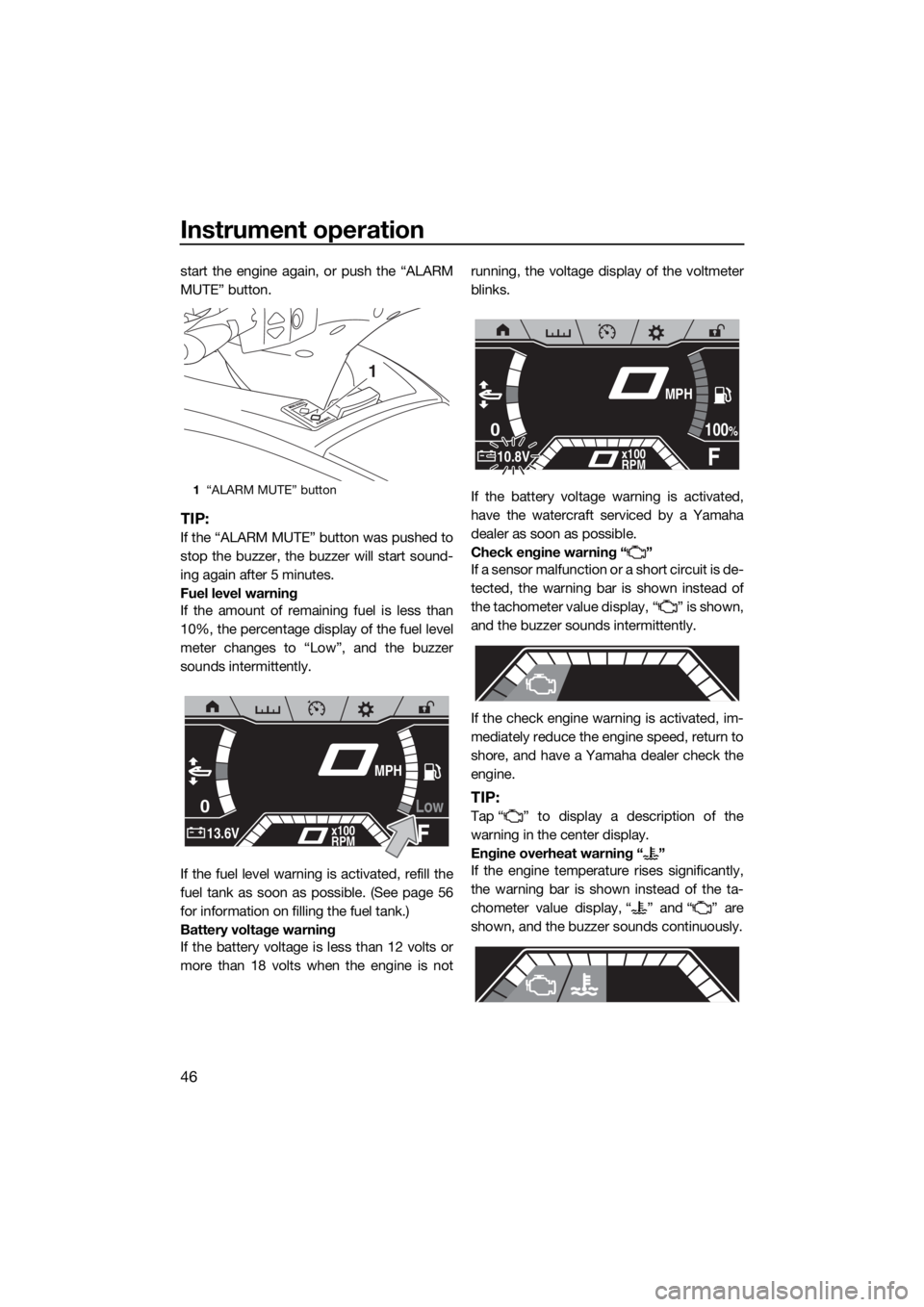
Instrument operation
46
start the engine again, or push the “ALARM
MUTE” button.
TIP:
If the “ALARM MUTE” button was pushed to
stop the buzzer, the buzzer will start sound-
ing again after 5 minutes.
Fuel level warning
If the amount of remaining fuel is less than
10%, the percentage display of the fuel level
meter changes to “Low”, and the buzzer
sounds intermittently.
If the fuel level warning is activated, refill the
fuel tank as soon as possible. (See page 56
for information on filling the fuel tank.)
Battery voltage warning
If the battery voltage is less than 12 volts or
more than 18 volts when the engine is notrunning, the voltage display of the voltmeter
blinks.
If the battery voltage warning is activated,
have the watercraft serviced by a Yamaha
dealer as soon as possible.
Check engine warning “ ”
If a sensor malfunction or a short circuit is de-
tected, the warning bar is shown instead of
the tachometer value display, “ ” is shown,
and the buzzer sounds intermittently.
If the check engine warning is activated, im-
mediately reduce the engine speed, return to
shore, and have a Yamaha dealer check the
engine.
TIP:
Tap “ ” to display a description of the
warning in the center display.
Engine overheat warning “ ”
If the engine temperature rises significantly,
the warning bar is shown instead of the ta-
chometer value display, “ ” and “ ” are
shown, and the buzzer sounds continuously.
1“ALARM MUTE” button
1
Low0
F13.6Vx100
RPM
MPH
0
F10.8Vx100
RPM
100%
MPH
UF3V70E0.book Page 46 Tuesday, August 28, 2018 10:16 AM
Page 66 of 116
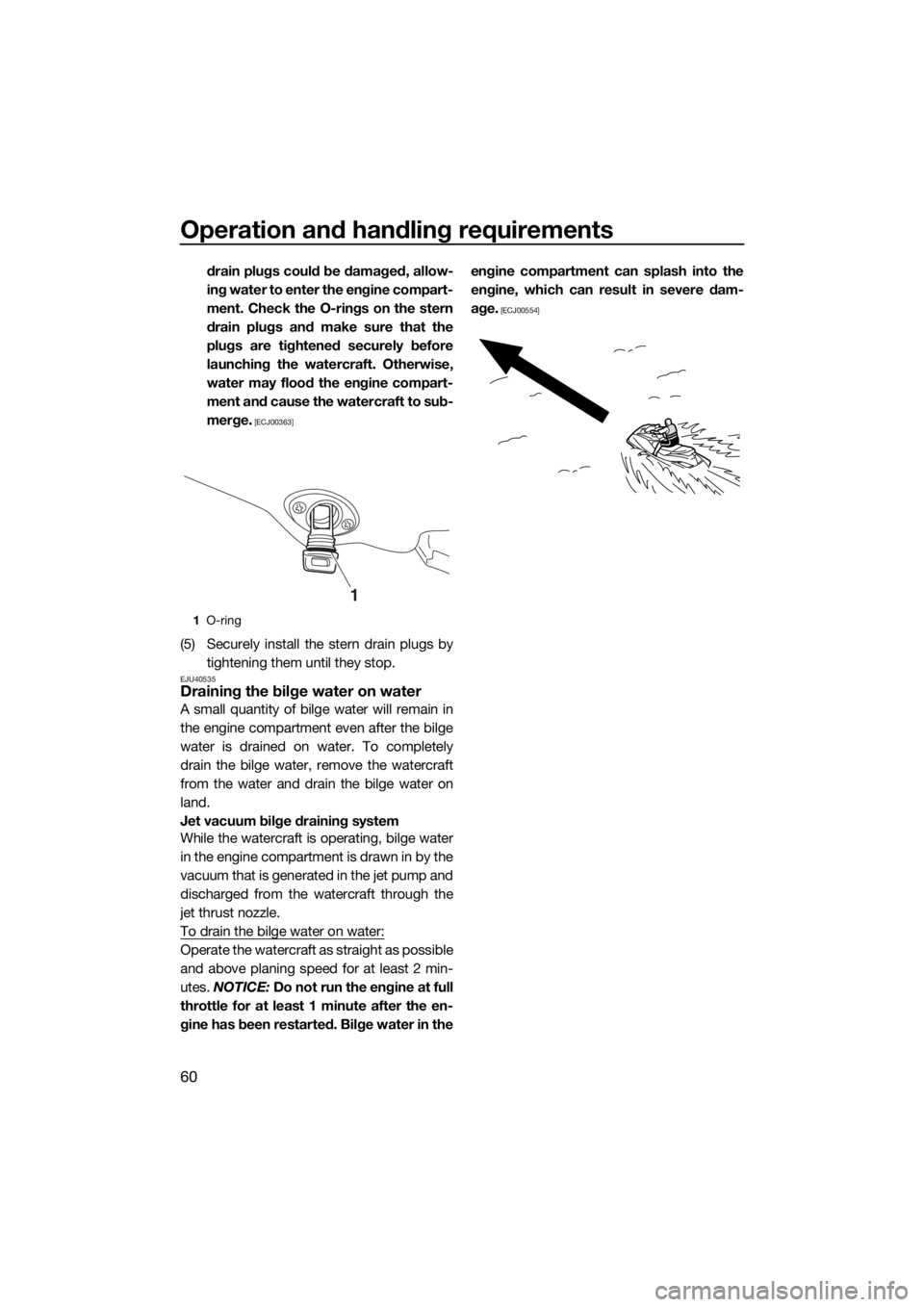
Operation and handling requirements
60
drain plugs could be damaged, allow-
ing water to enter the engine compart-
ment. Check the O-rings on the stern
drain plugs and make sure that the
plugs are tightened securely before
launching the watercraft. Otherwise,
water may flood the engine compart-
ment and cause the watercraft to sub-
merge.
[ECJ00363]
(5) Securely install the stern drain plugs by
tightening them until they stop.
EJU40535Draining the bilge water on water
A small quantity of bilge water will remain in
the engine compartment even after the bilge
water is drained on water. To completely
drain the bilge water, remove the watercraft
from the water and drain the bilge water on
land.
Jet vacuum bilge draining system
While the watercraft is operating, bilge water
in the engine compartment is drawn in by the
vacuum that is generated in the jet pump and
discharged from the watercraft through the
jet thrust nozzle.
To drain the bilge water on water:
Operate the watercraft as straight as possible
and above planing speed for at least 2 min-
utes. NOTICE: Do not run the engine at full
throttle for at least 1 minute after the en-
gine has been restarted. Bilge water in theengine compartment can splash into the
engine, which can result in severe dam-
age.
[ECJ00554]
1O-ring
1
UF3V70E0.book Page 60 Tuesday, August 28, 2018 10:16 AM
Page 69 of 116

Pre-operation checks
63
EJU31982
WARNING
EWJ00412
Failure to inspect or maintain the watercraft properly increases the possibility of an ac-
cident or damage to the watercraft. Do not operate the watercraft if you find any prob-
lem. If a problem cannot be corrected by the procedures provided in this manual, have
the watercraft inspected by a Yamaha dealer.
EJU41235Pre-operation checklist
Before using this watercraft, be sure to perform the checks in the following checklist.
ITEM ROUTINE PAGE
PRE-LAUNCH CHECKS
Engine compartmentVentilate the engine compartment.
Check inside the engine compartment for damage.65
Fuel systemCheck the fuel system for leakage.
Check the fuel level in the fuel tank.65
Water separatorCheck the water separator for water. 66
Engine unitCheck the exterior of the engine unit for damage. 66
Engine oil levelCheck the engine oil level. 66
Bilge waterCheck the engine compartment for bilge water. 66
BatteryCheck the battery connections and electrolyte level. 66
Steering systemCheck the steering system for proper operation. 67
Adjustable tilt steering sys-
temCheck the adjustable tilt steering system for proper
operation and check that the handlebars are se-
curely locked in place.68
RiDE lever Check the RiDE lever for proper operation. 68
Throttle leverCheck the throttle lever for proper operation. 68
Yamaha Security SystemCheck the Yamaha Security System for proper op-
eration.69
Engine shut-off cord (lan-
yard)Check the engine shut-off cord (lanyard) for dam-
age.69
SwitchesCheck the start switch, engine stop switch, and en-
gine shut-off switch for proper operation.69
Electric trim systemCheck the electric trim system for proper operation. 69
Storage compartmentsCheck the storage compartments for damage and
water.70
Fire extinguisher holder,
cover, and bandCheck the fire extinguisher holder, cover, and band
for damage.70
Fire extinguisherCheck the condition of the fire extinguisher. 70
Safety equipmentCheck that safety equipment meeting the applica-
ble regulations is on board.70
Hull and deckCheck the hull and deck for damage. 70
Jet intakeCheck the jet intake for damage and clogging. 70
UF3V70E0.book Page 63 Tuesday, August 28, 2018 10:16 AM
Page 75 of 116
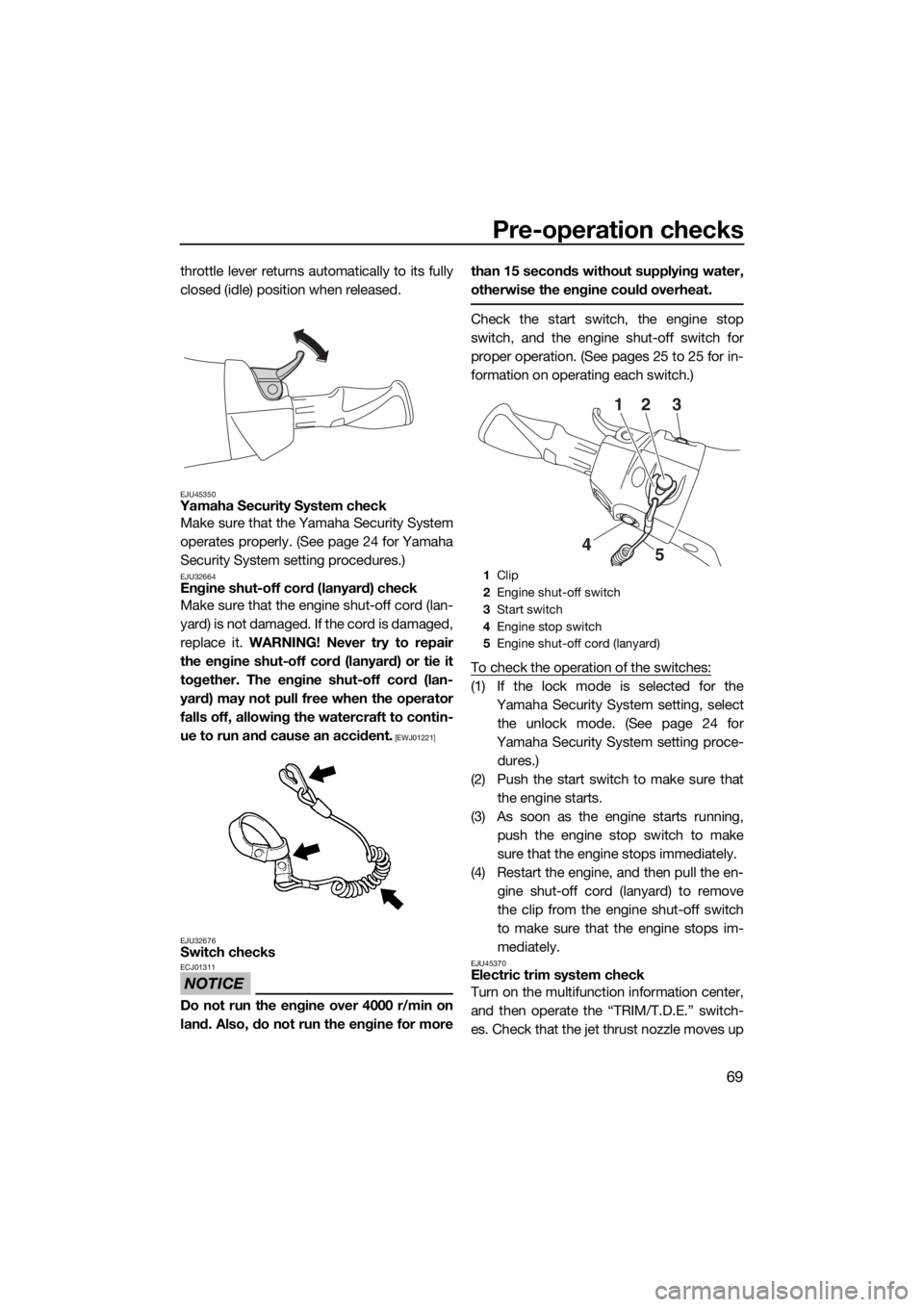
Pre-operation checks
69
throttle lever returns automatically to its fully
closed (idle) position when released.
EJU45350Yamaha Security System check
Make sure that the Yamaha Security System
operates properly. (See page 24 for Yamaha
Security System setting procedures.)
EJU32664Engine shut-off cord (lanyard) check
Make sure that the engine shut-off cord (lan-
yard) is not damaged. If the cord is damaged,
replace it. WARNING! Never try to repair
the engine shut-off cord (lanyard) or tie it
together. The engine shut-off cord (lan-
yard) may not pull free when the operator
falls off, allowing the watercraft to contin-
ue to run and cause an accident.
[EWJ01221]
EJU32676
Switch checks
NOTICE
ECJ01311
Do not run the engine over 4000 r/min on
land. Also, do not run the engine for morethan 15 seconds without supplying water,
otherwise the engine could overheat.
Check the start switch, the engine stop
switch, and the engine shut-off switch for
proper operation. (See pages 25 to 25 for in-
formation on operating each switch.)
To check the operation of the switches:
(1) If the lock mode is selected for the
Yamaha Security System setting, select
the unlock mode. (See page 24 for
Yamaha Security System setting proce-
dures.)
(2) Push the start switch to make sure that
the engine starts.
(3) As soon as the engine starts running,
push the engine stop switch to make
sure that the engine stops immediately.
(4) Restart the engine, and then pull the en-
gine shut-off cord (lanyard) to remove
the clip from the engine shut-off switch
to make sure that the engine stops im-
mediately.
EJU45370Electric trim system check
Turn on the multifunction information center,
and then operate the “TRIM/T.D.E.” switch-
es. Check that the jet thrust nozzle moves up
1Clip
2Engine shut-off switch
3Start switch
4Engine stop switch
5Engine shut-off cord (lanyard)
12 3
5 4
UF3V70E0.book Page 69 Tuesday, August 28, 2018 10:16 AM
Page 81 of 116
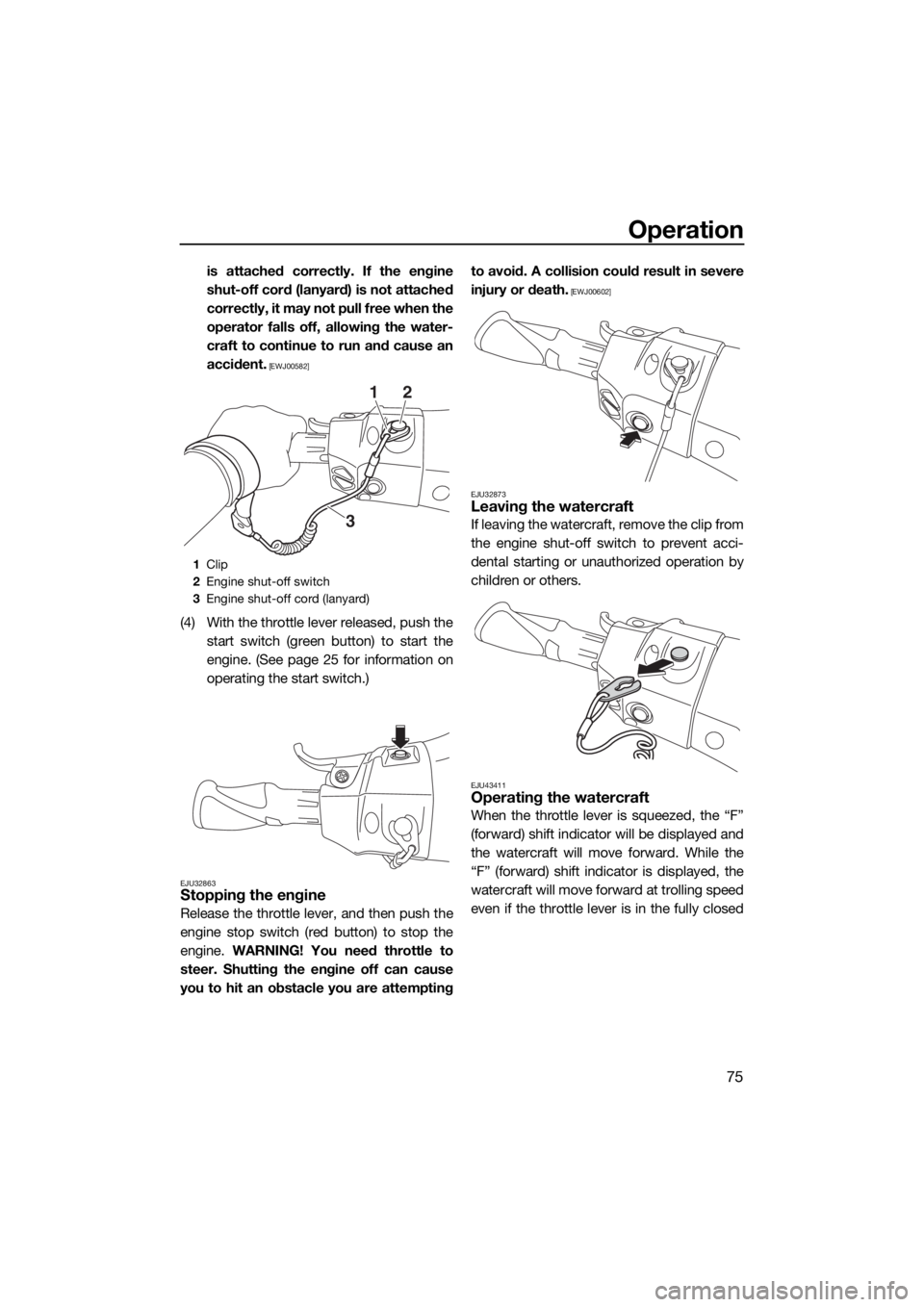
Operation
75
is attached correctly. If the engine
shut-off cord (lanyard) is not attached
correctly, it may not pull free when the
operator falls off, allowing the water-
craft to continue to run and cause an
accident.
[EWJ00582]
(4) With the throttle lever released, push the
start switch (green button) to start the
engine. (See page 25 for information on
operating the start switch.)
EJU32863Stopping the engine
Release the throttle lever, and then push the
engine stop switch (red button) to stop the
engine. WARNING! You need throttle to
steer. Shutting the engine off can cause
you to hit an obstacle you are attemptingto avoid. A collision could result in severe
injury or death.
[EWJ00602]
EJU32873
Leaving the watercraft
If leaving the watercraft, remove the clip from
the engine shut-off switch to prevent acci-
dental starting or unauthorized operation by
children or others.
EJU43411Operating the watercraft
When the throttle lever is squeezed, the “F”
(forward) shift indicator will be displayed and
the watercraft will move forward. While the
“F” (forward) shift indicator is displayed, the
watercraft will move forward at trolling speed
even if the throttle lever is in the fully closed
1Clip
2Engine shut-off switch
3Engine shut-off cord (lanyard)
2
3
1
UF3V70E0.book Page 75 Tuesday, August 28, 2018 10:16 AM
Page 86 of 116
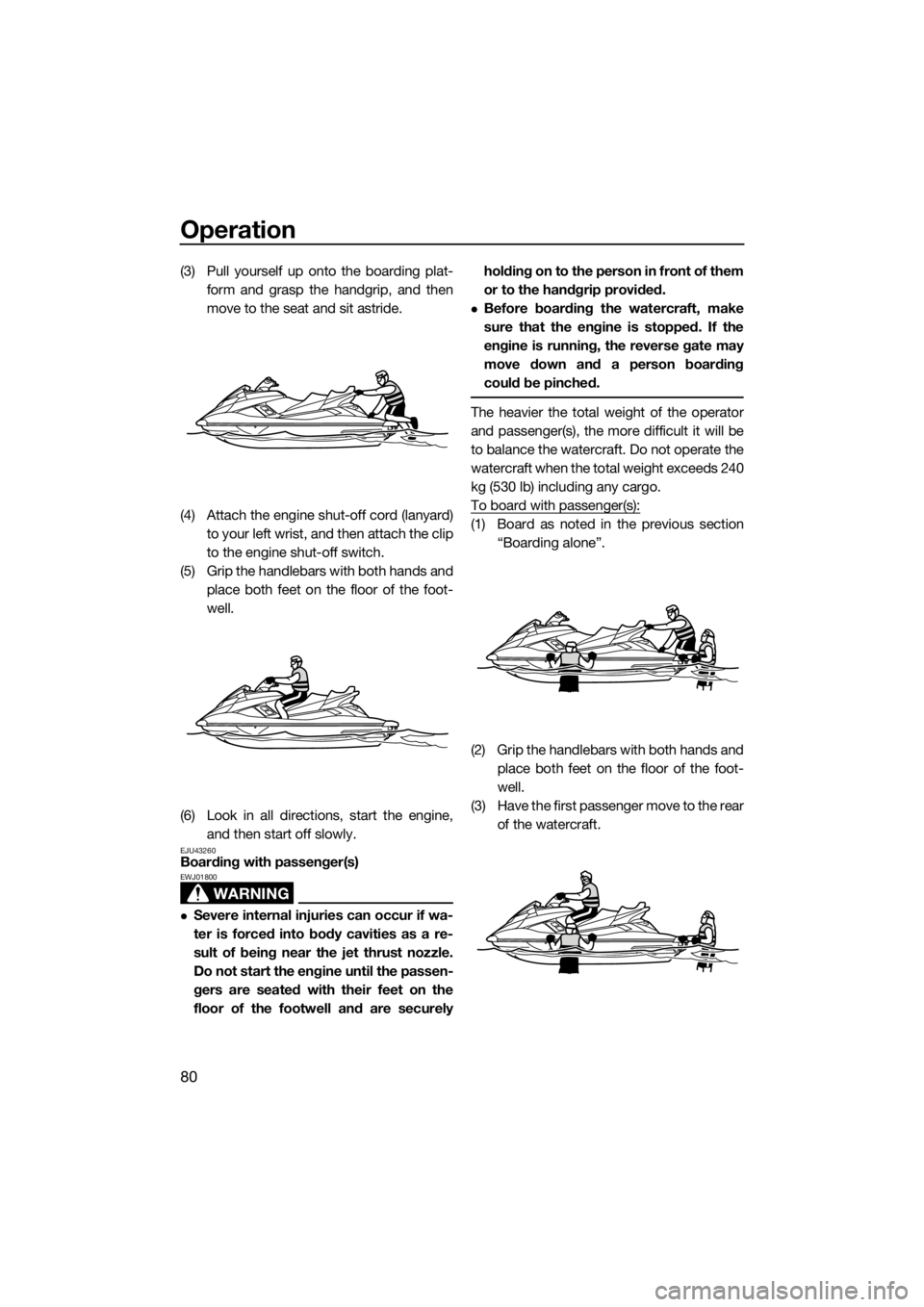
Operation
80
(3) Pull yourself up onto the boarding plat-
form and grasp the handgrip, and then
move to the seat and sit astride.
(4) Attach the engine shut-off cord (lanyard)
to your left wrist, and then attach the clip
to the engine shut-off switch.
(5) Grip the handlebars with both hands and
place both feet on the floor of the foot-
well.
(6) Look in all directions, start the engine,
and then start off slowly.
EJU43260Boarding with passenger(s)
WARNING
EWJ01800
Severe internal injuries can occur if wa-
ter is forced into body cavities as a re-
sult of being near the jet thrust nozzle.
Do not start the engine until the passen-
gers are seated with their feet on the
floor of the footwell and are securelyholding on to the person in front of them
or to the handgrip provided.
Before boarding the watercraft, make
sure that the engine is stopped. If the
engine is running, the reverse gate may
move down and a person boarding
could be pinched.
The heavier the total weight of the operator
and passenger(s), the more difficult it will be
to balance the watercraft. Do not operate the
watercraft when the total weight exceeds 240
kg (530 lb) including any cargo.
To board with passenger(s):
(1) Board as noted in the previous section
“Boarding alone”.
(2) Grip the handlebars with both hands and
place both feet on the floor of the foot-
well.
(3) Have the first passenger move to the rear
of the watercraft.
UF3V70E0.book Page 80 Tuesday, August 28, 2018 10:16 AM
Page 89 of 116
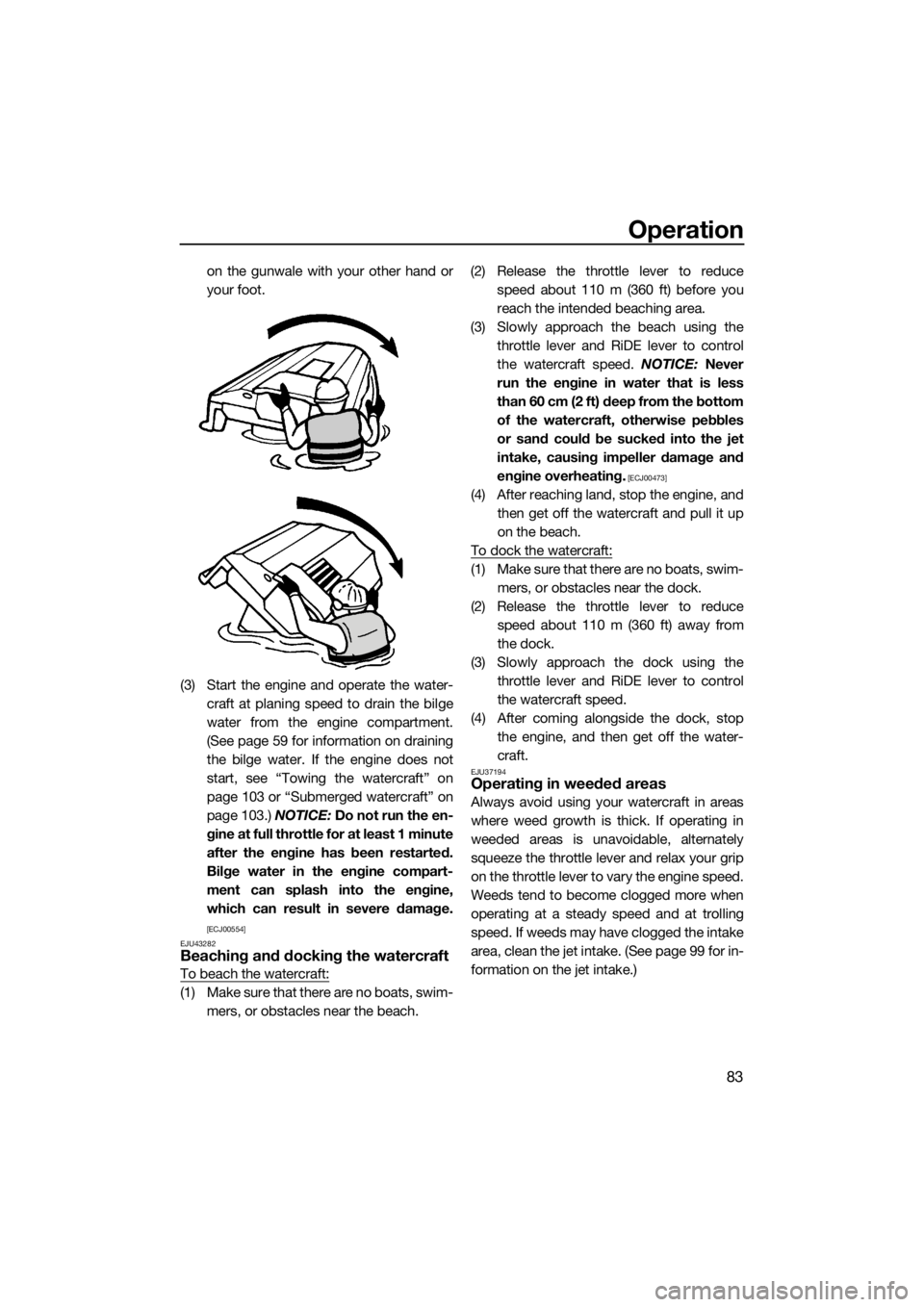
Operation
83
on the gunwale with your other hand or
your foot.
(3) Start the engine and operate the water-
craft at planing speed to drain the bilge
water from the engine compartment.
(See page 59 for information on draining
the bilge water. If the engine does not
start, see “Towing the watercraft” on
page 103 or “Submerged watercraft” on
page 103.) NOTICE: Do not run the en-
gine at full throttle for at least 1 minute
after the engine has been restarted.
Bilge water in the engine compart-
ment can splash into the engine,
which can result in severe damage.
[ECJ00554]
EJU43282
Beaching and docking the watercraft
To beach the watercraft:
(1) Make sure that there are no boats, swim-
mers, or obstacles near the beach.(2) Release the throttle lever to reduce
speed about 110 m (360 ft) before you
reach the intended beaching area.
(3) Slowly approach the beach using the
throttle lever and RiDE lever to control
the watercraft speed. NOTICE: Never
run the engine in water that is less
than 60 cm (2 ft) deep from the bottom
of the watercraft, otherwise pebbles
or sand could be sucked into the jet
intake, causing impeller damage and
engine overheating.
[ECJ00473]
(4) After reaching land, stop the engine, and
then get off the watercraft and pull it up
on the beach.
To dock the watercraft:
(1) Make sure that there are no boats, swim-
mers, or obstacles near the dock.
(2) Release the throttle lever to reduce
speed about 110 m (360 ft) away from
the dock.
(3) Slowly approach the dock using the
throttle lever and RiDE lever to control
the watercraft speed.
(4) After coming alongside the dock, stop
the engine, and then get off the water-
craft.
EJU37194Operating in weeded areas
Always avoid using your watercraft in areas
where weed growth is thick. If operating in
weeded areas is unavoidable, alternately
squeeze the throttle lever and relax your grip
on the throttle lever to vary the engine speed.
Weeds tend to become clogged more when
operating at a steady speed and at trolling
speed. If weeds may have clogged the intake
area, clean the jet intake. (See page 99 for in-
formation on the jet intake.)
UF3V70E0.book Page 83 Tuesday, August 28, 2018 10:16 AM
Page 90 of 116

Operation
84
EJU40242After removing the watercraft from
the water
NOTICE
ECJ01311
Do not run the engine over 4000 r/min on
land. Also, do not run the engine for more
than 15 seconds without supplying water,
otherwise the engine could overheat.
After operating and removing the watercraft
from the water, promptly discharge the re-
maining water from the cooling water pas-
sages.
To discharge water from the cooling water
passages:
(1) Make sure that the area around the wa-
tercraft is clear, and then start the en-
gine.
(2) Discharge the remaining water out of the
cooling water passages by alternately
squeezing and releasing the throttle lever
quickly for 10 to 15 seconds.
(3) Stop the engine.
UF3V70E0.book Page 84 Tuesday, August 28, 2018 10:16 AM
Page 106 of 116
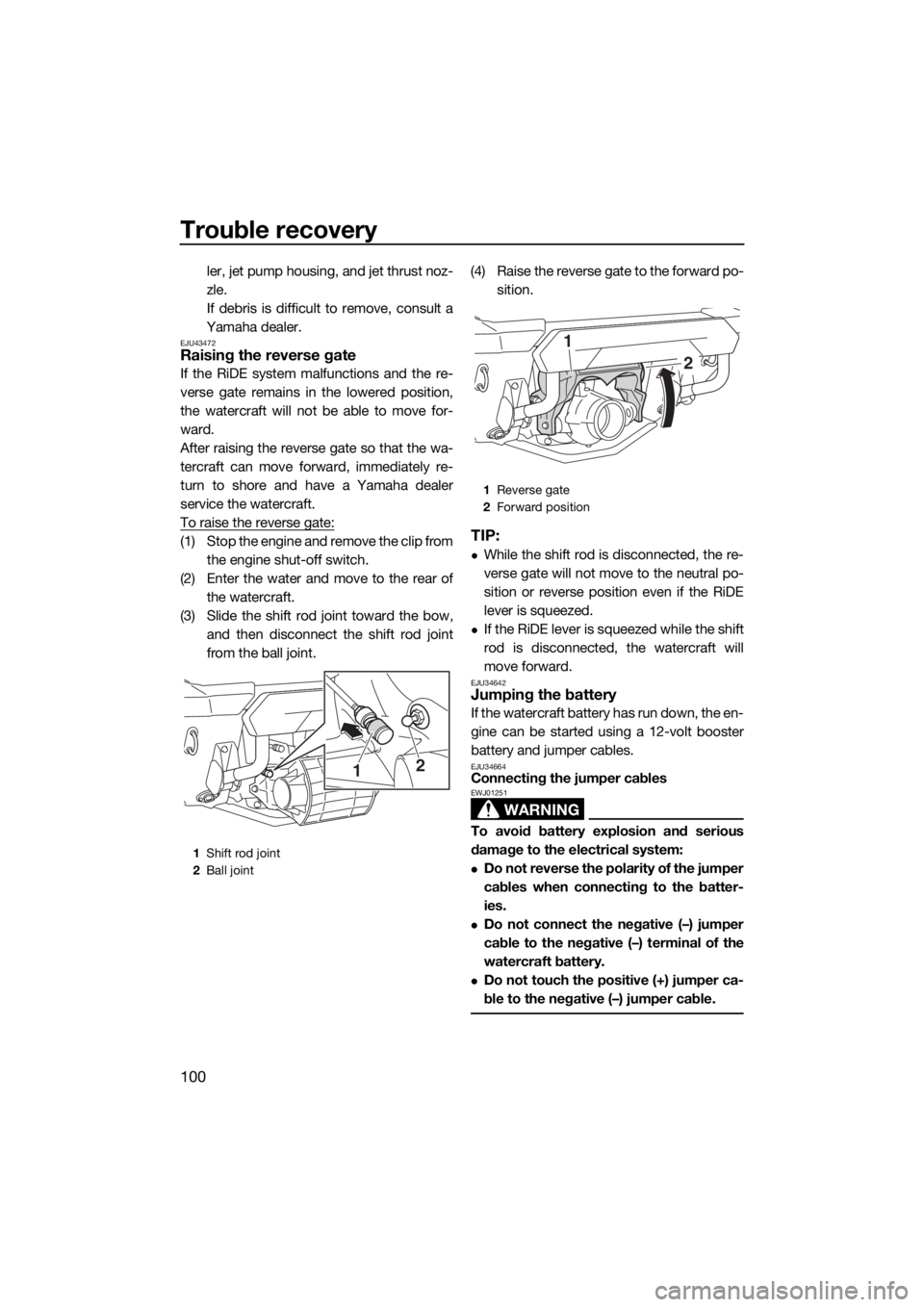
Trouble recovery
100
ler, jet pump housing, and jet thrust noz-
zle.
If debris is difficult to remove, consult a
Yamaha dealer.
EJU43472Raising the reverse gate
If the RiDE system malfunctions and the re-
verse gate remains in the lowered position,
the watercraft will not be able to move for-
ward.
After raising the reverse gate so that the wa-
tercraft can move forward, immediately re-
turn to shore and have a Yamaha dealer
service the watercraft.
To raise the reverse gate:
(1) Stop the engine and remove the clip from
the engine shut-off switch.
(2) Enter the water and move to the rear of
the watercraft.
(3) Slide the shift rod joint toward the bow,
and then disconnect the shift rod joint
from the ball joint.(4) Raise the reverse gate to the forward po-
sition.TIP:
While the shift rod is disconnected, the re-
verse gate will not move to the neutral po-
sition or reverse position even if the RiDE
lever is squeezed.
If the RiDE lever is squeezed while the shift
rod is disconnected, the watercraft will
move forward.
EJU34642Jumping the battery
If the watercraft battery has run down, the en-
gine can be started using a 12-volt booster
battery and jumper cables.
EJU34664Connecting the jumper cables
WARNING
EWJ01251
To avoid battery explosion and serious
damage to the electrical system:
Do not reverse the polarity of the jumper
cables when connecting to the batter-
ies.
Do not connect the negative (–) jumper
cable to the negative (–) terminal of the
watercraft battery.
Do not touch the positive (+) jumper ca-
ble to the negative (–) jumper cable.
1Shift rod joint
2Ball joint
12
1Reverse gate
2Forward position
2
1
UF3V70E0.book Page 100 Tuesday, August 28, 2018 10:16 AM
Page 111 of 116

105
Index
A
Adjustable tilt steering system ................. 27
Adjustable tilt steering system checks .... 68
After removing the watercraft from the
water ..................................................... 84
B
Battery care.............................................. 86
Battery checks ......................................... 66
Battery, jumping ..................................... 100
Beaching and docking the watercraft ...... 83
Beverage holder ....................................... 53
Bilge water check..................................... 66
Bilge water, draining ................................ 59
Bilge water, draining on land ................... 59
Bilge water, draining on water ................. 60
Boarding alone ......................................... 79
Boarding and starting off from a dock ..... 82
Boarding the watercraft ........................... 79
Boarding with passenger(s) ..................... 80
Bow eye ................................................... 50
Bow storage compartment ...................... 51
Builder’s plate ............................................ 2
C
Capsized watercraft ................................. 82
Cleaning ................................................... 89
Cleaning the watercraft ............................ 86
Cleat ......................................................... 50
Cooling water pilot outlet ......................... 28
Cooling water pilot outlet check .............. 72
Craft Identification Number (CIN)............... 1
Cruise assist............................................. 37
Cruising limitations................................... 10
D
Drive control mode................................... 35
Drive control mode screen ....................... 43
E
Electric trim system.................................. 31
Electric trim system check ....................... 69
Emergency procedures ............................ 99
Engine break-in ........................................ 62
Engine compartment check ..................... 65
Engine cover, removing and installing ..... 90
Engine idling speed check ....................... 72
Engine lock screen ................................... 45
Engine oil ................................................. 58Engine oil and oil filter .............................. 94
Engine oil level check ............................... 66
Engine oil requirements ........................... 58
Engine serial number ................................. 1
Engine shut-off cord (lanyard) check ....... 69
Engine shut-off switch ............................. 25
Engine stop switch ................................... 25
Engine unit check ..................................... 66
Enjoy your watercraft responsibly ............ 18
Equipment ................................................ 48
F
Fire extinguisher check ............................ 70
Fire extinguisher holder and cover........... 54
Fire extinguisher holder, cover, and
band checks ......................................... 70
Flushing the cooling water passages....... 85
Fuel .......................................................... 56
Fuel level check........................................ 65
Fuel requirements .................................... 56
Fuel system checks ................................. 65
Fuses, replacing ..................................... 101
G
Getting to know your watercraft .............. 73
Glossary, watercraft ................................. 19
Glove compartment ................................. 52
H
Handgrip .................................................. 49
Hazard information................................... 14
Home screen ............................................ 41
Hood check .............................................. 71
Hull and deck check ................................ 70
I
Identification numbers ............................... 1
Information screen ................................... 42
J
Jet intake and impeller, cleaning.............. 99
Jet intake checks ..................................... 70
Jet thrust nozzle and reverse gate
check .................................................... 70
Jumper cables, connecting .................... 100
L
Labels, important ....................................... 4
Labels, other .............................................. 8
Labels, warning .......................................... 5
Launching the watercraft ......................... 74
UF3V70E0.book Page 105 Tuesday, August 28, 2018 10:16 AM